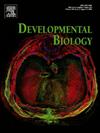Tunicate-specific protein Epi-1 is essential for conferring hydrophilicity to the larval tunic in the ascidian Ciona
IF 2.5
3区 生物学
Q2 DEVELOPMENTAL BIOLOGY
引用次数: 0
Abstract
Animals must avoid adhesion to objects in the environment to maintain their mobility and independence. The marine invertebrate chordate ascidians are characterized by an acellular matrix tunic enveloping their entire body for protection and swimming. The tunic of ascidian larvae consists of a surface cuticle layer and inner matrix layer. Hydrophilic substances coat the cuticle; this modification is thought to be for preventing adhesion. However, the molecule responsible for regulating this modification has not been clarified. We here found that the tunicate-specific protein Epi-1 is responsible for preventing adhesiveness of the tunic in the ascidian Ciona intestinalis Type A. Ciona mutants with homozygous knockouts of Epi-1 exhibited adhesion to plastic plates and to other individuals. The cuticle of the Epi-1 mutants was fragile, and it lost the glycosaminoglycans supplied by test cells, the accessory cells that normally attach to the tunic surface. Although it has an apparent signal peptide for membrane trafficking, we showed that the Epi-1 protein is localized to the cytosol of the epidermal cells. Our study suggests that the emergence of the tunicate-specific protein Epi-1 made the tunic less adhesive, providing a selective advantage for the last common tunicate ancestor.

被膜特异性蛋白Epi-1是赋予海鞘幼虫被膜亲水性所必需的。
动物必须避免附着在环境中的物体上,以保持它们的机动性和独立性。海洋无脊椎脊索动物海鞘的特征是全身包裹着一层脱细胞基质外衣,用于保护和游泳。海鞘幼虫的被膜由表层角质层和内层基质层组成。亲水物质覆盖角质层;这种修饰被认为是为了防止粘连。然而,调控这种修饰的分子尚未被阐明。我们在这里发现,被膜特异性蛋白Epi-1负责阻止a型海鞘的被膜粘附。纯合敲除Epi-1的海鞘突变体表现出对塑料板和其他个体的粘附。Epi-1突变体的角质层是脆弱的,它失去了由测试细胞提供的糖胺聚糖,这些细胞通常附着在外衣表面。虽然它有一个明显的信号肽膜运输,我们发现Epi-1蛋白定位于表皮细胞的细胞质。我们的研究表明,被囊动物特异性蛋白Epi-1的出现使被囊动物的粘附性降低,为最后一个共同的被囊动物祖先提供了选择优势。
本文章由计算机程序翻译,如有差异,请以英文原文为准。
求助全文
约1分钟内获得全文
求助全文
来源期刊

Developmental biology
生物-发育生物学
CiteScore
5.30
自引率
3.70%
发文量
182
审稿时长
1.5 months
期刊介绍:
Developmental Biology (DB) publishes original research on mechanisms of development, differentiation, and growth in animals and plants at the molecular, cellular, genetic and evolutionary levels. Areas of particular emphasis include transcriptional control mechanisms, embryonic patterning, cell-cell interactions, growth factors and signal transduction, and regulatory hierarchies in developing plants and animals.
 求助内容:
求助内容: 应助结果提醒方式:
应助结果提醒方式:


